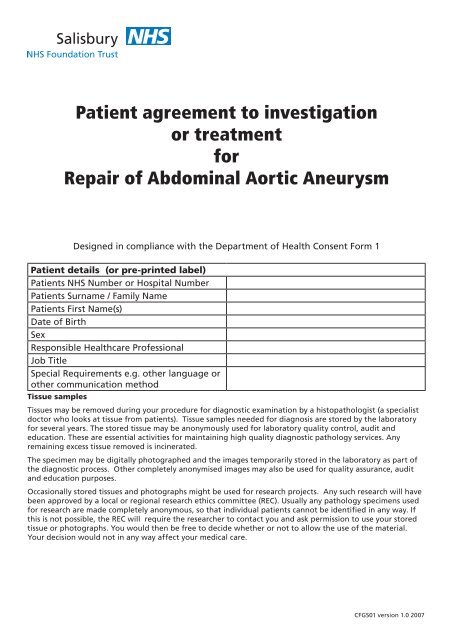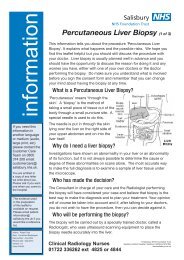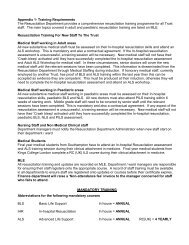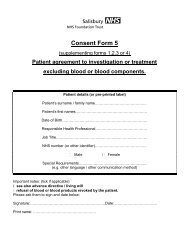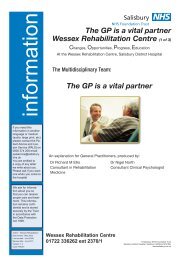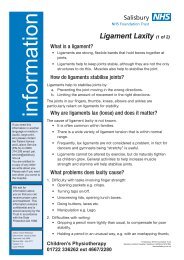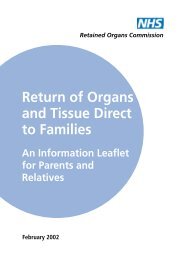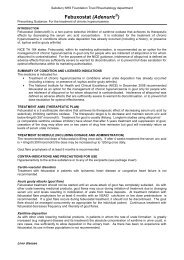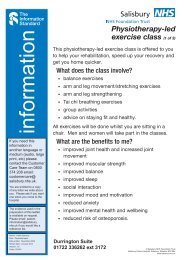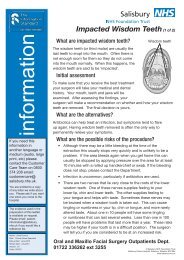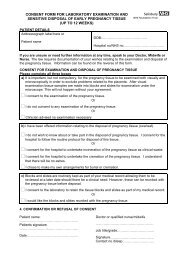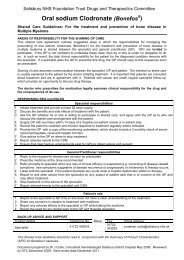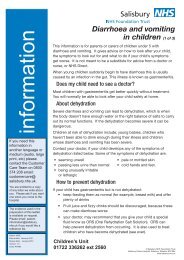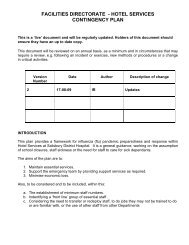Abdominal Aortic Aneurysm Repair Consent - ICID
Abdominal Aortic Aneurysm Repair Consent - ICID
Abdominal Aortic Aneurysm Repair Consent - ICID
Create successful ePaper yourself
Turn your PDF publications into a flip-book with our unique Google optimized e-Paper software.
Patient agreement to investigation<br />
or treatment<br />
for<br />
<strong>Repair</strong> of <strong>Abdominal</strong> <strong>Aortic</strong> <strong>Aneurysm</strong><br />
Designed in compliance with the Department of Health <strong>Consent</strong> Form 1<br />
Patient details (or pre-printed label)<br />
Patients NHS Number or Hospital Number<br />
Patients Surname / Family Name<br />
Patients First Name(s)<br />
Date of Birth<br />
Sex<br />
Responsible Healthcare Professional<br />
Job Title<br />
Special Requirements e.g. other language or<br />
other communication method<br />
Tissue samples<br />
Tissues may be removed during your procedure for diagnostic examination by a histopathologist (a specialist<br />
doctor who looks at tissue from patients). Tissue samples needed for diagnosis are stored by the laboratory<br />
for several years. The stored tissue may be anonymously used for laboratory quality control, audit and<br />
education. These are essential activities for maintaining high quality diagnostic pathology services. Any<br />
remaining excess tissue removed is incinerated.<br />
The specimen may be digitally photographed and the images temporarily stored in the laboratory as part of<br />
the diagnostic process. Other completely anonymised images may also be used for quality assurance, audit<br />
and education purposes.<br />
Occasionally stored tissues and photographs might be used for research projects. Any such research will have<br />
been approved by a local or regional research ethics committee (REC). Usually any pathology specimens used<br />
for research are made completely anonymous, so that individual patients cannot be identified in any way. If<br />
this is not possible, the REC will require the researcher to contact you and ask permission to use your stored<br />
tissue or photographs. You would then be free to decide whether or not to allow the use of the material.<br />
Your decision would not in any way affect your medical care.<br />
CFGS01 version 1.0 2007
Patient identifier/label<br />
Notes Copy<br />
Name of Proposed Procedure (include<br />
a brief explanation if medical term not clear)<br />
<strong>Abdominal</strong> aortic aneurysm repair - repair of<br />
a ballooned artery in your abdomen<br />
Anaesthetic<br />
General / regional Local Sedation<br />
Statement of health professional (To be filled in by health professional with appropriate<br />
knowledge of the proposed procedure, as specified in the consent policy).<br />
I have explained the procedure to the patient. In particular, I have explained:<br />
The intended benefits: To reduce the risk of aneurysm rupture / bleeding and death.<br />
Serious or frequently occurring risks<br />
bleeding (return to theatre)<br />
wound infection / graft infection<br />
kidney impairment / heart attack / stroke<br />
thromboembolic problems causing worsening blood flow<br />
sexual dysfunction / bowel ischaemia<br />
death (around 5% depending on medical condition)<br />
Pre-assessment<br />
Nurse / Surgeon<br />
General risks of the procedure<br />
small areas of the lung may collapse, increasing the risk of a chest infection. This may<br />
need antibiotics and physiotherapy.<br />
clots in the legs (deep vein thrombosis or DVT) with pain and swelling. Rarely part of<br />
this clot may break off and go to the lung which can be fatal.<br />
a heart attack because of strain on the heart or a stroke.<br />
risks of anaesthesia - please see leaflet.<br />
Please note these risks are increased if you are overweight or a smoker<br />
Any extra procedures which may become necessary during the procedure<br />
blood transfusion<br />
other procedure (please specify)................................................................................................................<br />
I have discussed what the procedure is likely to involve, the benefits and risks any available<br />
alternative treatments (including no treatment) and any particular concerns of this patient.<br />
The following leaflet / tape has been provided:<br />
<br />
<br />
<br />
<br />
<br />
<br />
<br />
Signed:<br />
Date:<br />
Name (PRINT)<br />
Job Title:<br />
Contact Details (if patient wishes to discuss options later)<br />
Statement of interpreter (where appropriate). I have interpreted the information<br />
above to the patient to the best of my ability and in a way I believe s/he can understand.<br />
Signature of Interpreter Name (print) Date<br />
Copy accepted by patient: yes / No (please ring)<br />
This copy to be retained in patient’s notes<br />
CFGS01 version 1.0 2007
Patient identifier/label<br />
Patient’s Copy<br />
Name of Proposed Procedure (include<br />
a brief explanation if medical term not clear)<br />
<strong>Abdominal</strong> aortic aneurysm repair - repair of<br />
a ballooned artery in your abdomen<br />
Anaesthetic<br />
General / regional Local Sedation<br />
Statement of health professional (To be filled in by health professional with appropriate<br />
knowledge of the proposed procedure, as specified in the consent policy).<br />
I have explained the procedure to the patient. In particular, I have explained:<br />
The intended benefits: To reduce the risk of aneurysm rupture / bleeding and death.<br />
Serious or frequently occurring risks<br />
bleeding (return to theatre)<br />
wound infection / graft infection<br />
kidney impairment / heart attack / stroke<br />
thromboembolic problems causing worsening blood flow<br />
sexual dysfunction / bowel ischaemia<br />
death (around 5% depending on medical condition)<br />
Pre-assessment<br />
Nurse/ surgeon<br />
General risks of the procedure<br />
small areas of the lung may collapse, increasing the risk of a chest infection. This may<br />
need antibiotics and physiotherapy.<br />
clots in the legs (deep vein thrombosis or DVT) with pain and swelling. Rarely part of<br />
this clot may break off and go to the lung which can be fatal.<br />
a heart attack because of strain on the heart or a stroke.<br />
risks of anaesthesia - please see leaflet.<br />
Please note these risks are increased if you are overweight or a smoker<br />
Any extra procedures which may become necessary during the procedure:<br />
blood transfusion<br />
other procedure (please specify)................................................................................................................<br />
I have discussed what the procedure is likely to involve, the benefits and risks any available<br />
alternative treatments (including no treatment) and any particular concerns of this patient.<br />
The following leaflet / tape has been provided:<br />
<br />
<br />
<br />
<br />
<br />
<br />
<br />
Signed:<br />
Date:<br />
Name (PRINT)<br />
Job Title:<br />
Contact Details (if patient wishes to discuss options later)<br />
Statement of interpreter (where appropriate). I have interpreted the information<br />
above to the patient to the best of my ability and in a way I believe s/he can understand.<br />
Signature of Interpreter Name (print) Date<br />
Patient’s copy<br />
CFGS01 version 1.0 2007
Patient identifier/label<br />
Statement of patient<br />
Please read this form carefully. If your treatment has been planned in advance, you<br />
should already have your own copy of page 2, which describes the benefits and risks of<br />
the proposed treatment. If not, you will be offered a copy now. If you have any further<br />
questions, do ask - we are here to help you. You have the right to change your mind at any<br />
time, including after you have signed this form.<br />
I agree to the procedure or course of treatment described on this form.<br />
I understand that you cannot give me a guarantee that a particular person will perform the<br />
procedure. The person will, however, have appropriate experience.<br />
I understand that I will have the opportunity to discuss the details of anaesthesia with an<br />
anaesthetist before the procedure, unless the urgency of my situation prevents this. (This<br />
only applies to patients having general or regional anaesthesia).<br />
I understand that any procedure in addition to the one described on this form will only be<br />
carried out if it is necessary to save my life or prevent serious harm to my health.<br />
I have been told about additional procedures which may become necessary during my<br />
treatment. I have listed below any procedures which I do not wish to be carried out without<br />
further discussion.<br />
Patient’s signature Name (PRINT) Date:<br />
A witness should sign below if the patient is unable to sign, but has indicated his or her<br />
consent. Young people/children may also like a parent to sign here (see notes).<br />
Signature Name (PRINT) Date:<br />
Confirmation of consent (to be completed by a health professional when the patient<br />
is admitted for the procedure, if the patient has signed the form in advance).<br />
On behalf of the team treating the patient, I have confirmed with the patient that s/he has<br />
no further questions and wishes the procedure to go ahead.<br />
Signed:<br />
Date<br />
Name (PRINT)<br />
Job Title<br />
Important notes: (tick if applicable)<br />
<br />
<br />
<br />
See also advanced directive/living will (e.g. Jehovah’s Witness form).<br />
Patient has withdrawn consent (ask patient to sign/date here)<br />
Patient agrees to the use of surplus tissue (ensure signed consent in notes).<br />
This page to be retained in patient’s notes<br />
CFGS01 version 1.0 2007


